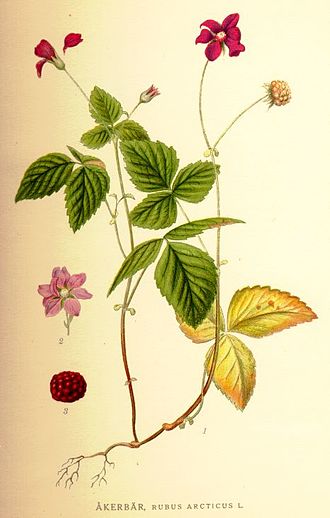Rubus arcticus
Rubus arcticus[edit]

Rubus arcticus, commonly known as the Arctic raspberry, is a species of flowering plant in the rose family, Rosaceae. It is native to the Arctic and boreal regions of Europe, Asia, and North America. This perennial plant is highly valued for its delicious berries and is often found in the wild in cold climates.
Description[edit]
Rubus arcticus is a low-growing, herbaceous perennial that typically reaches heights of 10 to 25 centimeters. The plant has a creeping rhizome system that allows it to spread across the ground. The leaves are compound, usually consisting of three leaflets, which are serrated and have a slightly hairy texture.
The flowers of Rubus arcticus are pink to purple and bloom in late spring to early summer. Each flower has five petals and is about 1 to 2 centimeters in diameter. The plant is self-sterile, meaning it requires cross-pollination from another plant to produce fruit.
Fruit[edit]

The fruit of Rubus arcticus is a small, aggregate berry that ripens in mid to late summer. The berries are typically red to dark purple and are known for their sweet and aromatic flavor. They are highly prized in northern regions for making jams, jellies, and desserts.
Habitat and Distribution[edit]
Rubus arcticus thrives in cold, moist environments. It is commonly found in tundra, boreal forests, and peat bogs. The plant prefers acidic soils and can often be found in areas with a high water table.
In North America, Rubus arcticus is found in Alaska, Canada, and the northern parts of the United States. In Europe, it is present in Scandinavia and parts of Russia. In Asia, it can be found in Siberia and the northern regions of Japan.
Cultivation[edit]
While Rubus arcticus is primarily a wild plant, it has been cultivated in some regions for its fruit. Cultivation requires a cool climate and well-drained, acidic soil. The plant is often propagated by division of the rhizomes or by seed.
Uses[edit]
The berries of Rubus arcticus are used in a variety of culinary applications. They are often eaten fresh or used to make preserves, syrups, and liqueurs. In some cultures, the berries are also used in traditional medicine.
Related pages[edit]
Ad. Transform your life with W8MD's Budget GLP-1 injections from $75


W8MD offers a medical weight loss program to lose weight in Philadelphia. Our physician-supervised medical weight loss provides:
- Weight loss injections in NYC (generic and brand names):
- Zepbound / Mounjaro, Wegovy / Ozempic, Saxenda
- Most insurances accepted or discounted self-pay rates. We will obtain insurance prior authorizations if needed.
- Generic GLP1 weight loss injections from $75 for the starting dose.
- Also offer prescription weight loss medications including Phentermine, Qsymia, Diethylpropion, Contrave etc.
NYC weight loss doctor appointmentsNYC weight loss doctor appointments
Start your NYC weight loss journey today at our NYC medical weight loss and Philadelphia medical weight loss clinics.
- Call 718-946-5500 to lose weight in NYC or for medical weight loss in Philadelphia 215-676-2334.
- Tags:NYC medical weight loss, Philadelphia lose weight Zepbound NYC, Budget GLP1 weight loss injections, Wegovy Philadelphia, Wegovy NYC, Philadelphia medical weight loss, Brookly weight loss and Wegovy NYC
|
WikiMD's Wellness Encyclopedia |
| Let Food Be Thy Medicine Medicine Thy Food - Hippocrates |
Medical Disclaimer: WikiMD is not a substitute for professional medical advice. The information on WikiMD is provided as an information resource only, may be incorrect, outdated or misleading, and is not to be used or relied on for any diagnostic or treatment purposes. Please consult your health care provider before making any healthcare decisions or for guidance about a specific medical condition. WikiMD expressly disclaims responsibility, and shall have no liability, for any damages, loss, injury, or liability whatsoever suffered as a result of your reliance on the information contained in this site. By visiting this site you agree to the foregoing terms and conditions, which may from time to time be changed or supplemented by WikiMD. If you do not agree to the foregoing terms and conditions, you should not enter or use this site. See full disclaimer.
Credits:Most images are courtesy of Wikimedia commons, and templates, categories Wikipedia, licensed under CC BY SA or similar.
Translate this page: - East Asian
中文,
日本,
한국어,
South Asian
हिन्दी,
தமிழ்,
తెలుగు,
Urdu,
ಕನ್ನಡ,
Southeast Asian
Indonesian,
Vietnamese,
Thai,
မြန်မာဘာသာ,
বাংলা
European
español,
Deutsch,
français,
Greek,
português do Brasil,
polski,
română,
русский,
Nederlands,
norsk,
svenska,
suomi,
Italian
Middle Eastern & African
عربى,
Turkish,
Persian,
Hebrew,
Afrikaans,
isiZulu,
Kiswahili,
Other
Bulgarian,
Hungarian,
Czech,
Swedish,
മലയാളം,
मराठी,
ਪੰਜਾਬੀ,
ગુજરાતી,
Portuguese,
Ukrainian